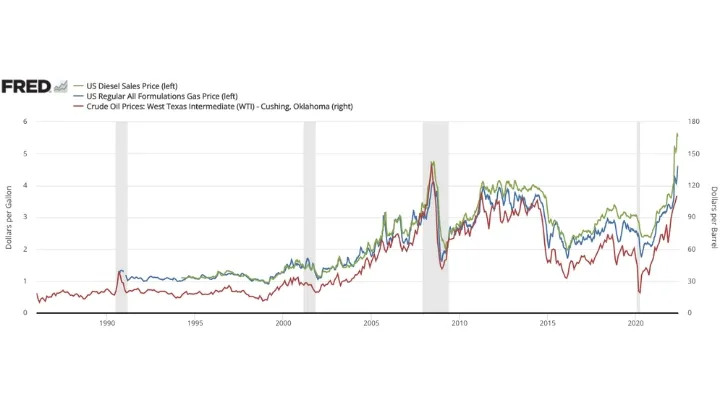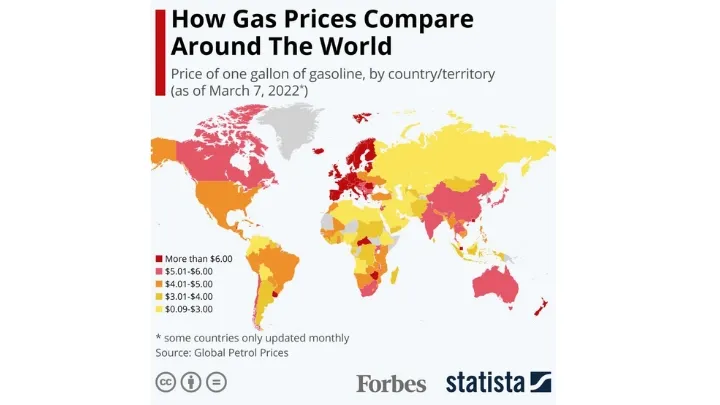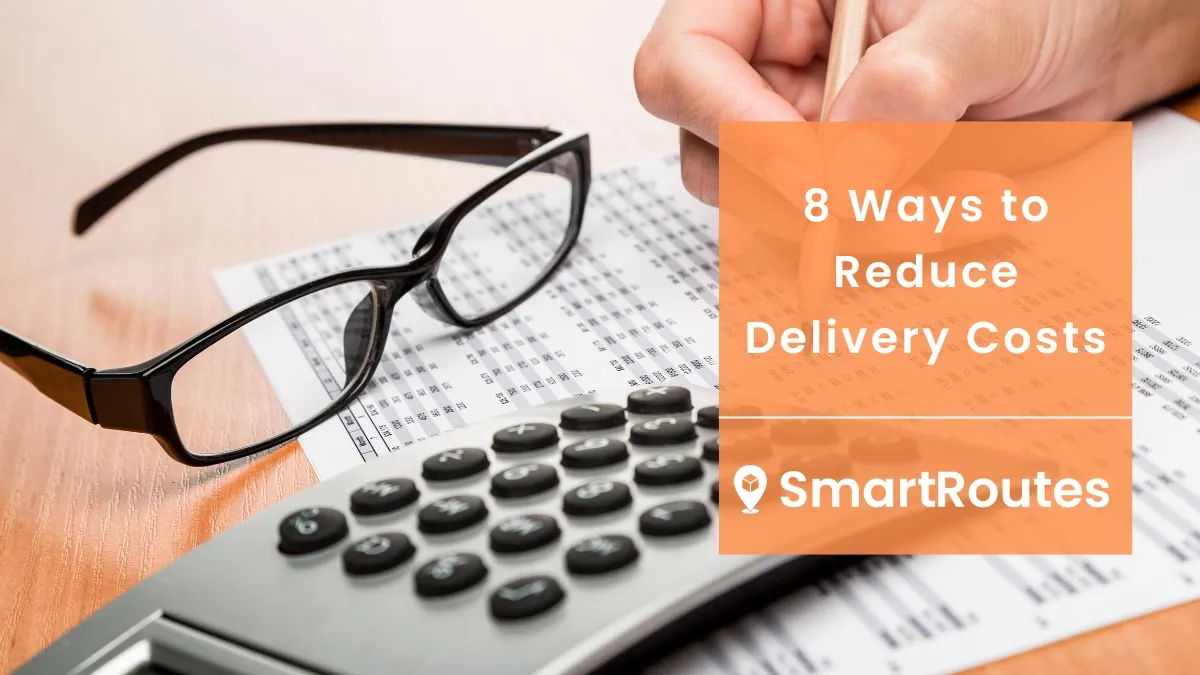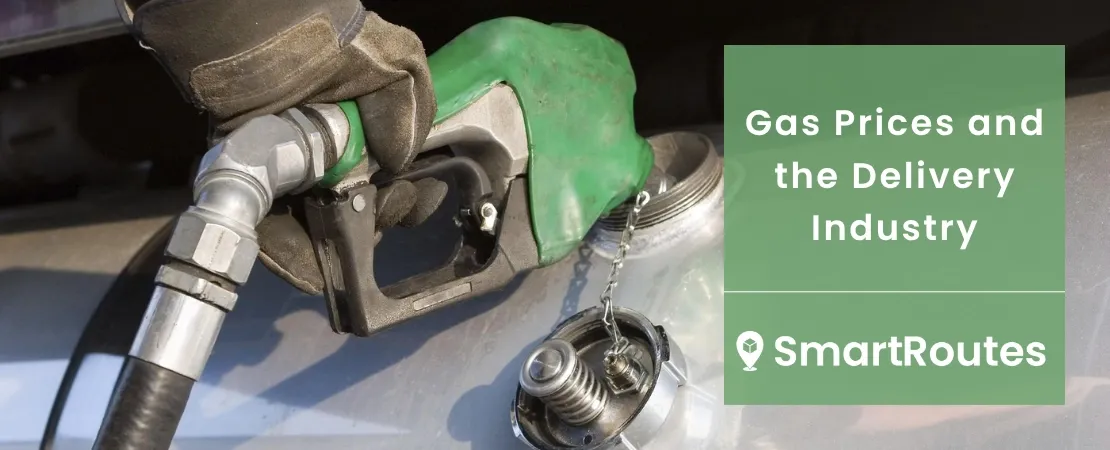Gas and diesel price increases and the delivery industry
Even if you are not in the delivery industry you will have noticed the huge rise in gas and diesel prices in forecourts. Supply chain issues, the war in Ukraine and increasing taxation on fossil fuels are all contributing to a spike in costs.
The rising cost of diesel, gas and petrol
As you can see from the graph below fuel price spikes tend to be just that, and prices do come back down again but that might not be quick enough for many businesses who drive for a living.
Now, with the geopolitical uncertainties of 2022, we're at a new all-time high in fuel prices. This means that the last-mile professionals and the transportation industry are affected the most.
Changes in US diesel prices on the forecourt in green below.

If you are a delivery company or a company who needs to deliver, how can you contain the worst of this spike so your business does not become unprofitable?
The rise of global fuel prices and how it affects last-mile professionals
Oil and gas prices are never the same for too long. So how bad are things at the moment?
It can be easy to simply see the increases in how much it costs to fill your tank today but it can be useful to see it in terms of global trends over the past few decades.
Equally interesting is to see where in the world the most expensive diesel and gas prices are around the world. Hint: the most expensive places are those with the highest taxes on fuel in most cases.

Although the total increase is different from region to region, the general trend is that the curve is not flattening any time soon.
This year there has been a 60-70% increase in diesel but where does that leave businesses that are seeing huge increases in their costs while operating in an industry with razor-thin margins? The answer to this question is simply going to be more and more efficient use of fleets and a reduction in miles driven to do the same work. Let’s take a look at how that can be achieved by delivery professionals.
What is going to happen in the industry as a result of the fuel cost spike?
In last-mile delivery, fuel costs are typically the second largest contributor to the cost of a single delivery. The largest cost is, of course, labor. Even with electric vehicles becoming more popular fuel costs will continue to be a factor as charging large vehicles will incur significant costs also, particularly with energy prices surging also.
What is likely is you will see delivery fleets moving to electric vehicles faster as a result of this fuel cost spike. Alternatively, you will see cargo bikes, drones and zero-emission vehicles being used in conjunction with micro-fulfillment centres in urban and suburban areas.
Although there are zero-emissions delivery startups that use cargo bikes, by and large, there's no deliveries without fuel.
The reality for so much of last-mile is that vehicles are operating with only partial loads or even if they are fully loaded, it is with packages that contain relatively tiny items inside and mostly packaging material. This has to stop.
In the meantime last-mile delivery needs to take two major considerations into account.
- Optimize routes using AI
- Maximize the efficiency of vehicles on the road
How do you achieve all that? By using a fleet fuel management system.
SmartRoutes Route Planning Software
Streamline your entire delivery process, all from one platform

What is a fleet fuel management system?
In the most simple terms, delivery management is the process of controlling and monitoring how delivery operations take place. This can be applied to any mode of transport, although we’ll focus on road transport in particular. It includes things like route planning, route optimization, fleet tracking, operational oversight and reporting. All of these elements have an impact on fleet fuel management.
A fleet fuel management system is usually a subset of the delivery management system. It combines the route planning, tracking and optimization elements to reduce fuel consumption and help to predict future usage.
Here's exactly how a DMS like SmartRoutes works as a fleet fuel management system.
- Import your vehicles with all of their capacities and capabilities in SmartRoutes
- Import delivery/collection stops via spreadsheet, integration with your order management system or even manually
- Optimize your routes based on account parameters and using our unique AI algorithm to find the shortest routes
- Keep your vehicles optimally loaded with the ability to collect and deliver on the same route
- Cut out unnecessary vehicles, staff and depot ‘up-time’ by finding the most efficient route plans
- Get operational insights that can save you money such as optimizing delivery catchment areas and cutting out outlier stops
- Ensure the fleet is not being used for anything other than company business during work hours or out of hours.
The great thing about using SmartRoutes [or any other delivery management system] to control fuel consumption is you actually get a much more holistic solution for your company. You get added oversight, control and reporting across the board to connect order management to deliveries and on to customer experience. Win, win all round.
How SmartRoutes will cut your fuel costs
Diesel, gas and petrol prices are out of your control for now and the best thing you can do is minimize the impact on your cash flow while attempting to increase your charges on the back of a strong media narrative currently.
Let's look at SmartRoutes and how its eco friendly home delivery helps you bring your operational costs down and keep you safe from further increases in diesel prices.
1. Delivery route planning
Poor planning of last mile deliveries can increase your overall logistical costs by 20-40% making your operations unprofitable. Poor planning leads to long time windows and missed deliveries resulting in customer churn. Using a delivery planning software solves this problem for you. Reduction in the administrative overhead of planning routes frees up your time. All routes are sent directly to the driver via the delivery driver app.
Our entire logistics team is now using SmartRoutes functionality, and the support we’ve received from their team has been exceptional. It’s made life easier for everyone and the route optimization has made us more efficient across the board.
- Barry Rabbit, CEO of DeliverIt
2. Route optimization
Our route optimizing algorithm will reduce cost per delivery by at least 33% versus traditional planning and allow you to factor in complex variables like time windows, load balancing, zonal territories and even vehicle variables to avoid missed deliveries and deadlines. Vehicles leaving the depot fully loaded results in greater profitability.
3. Costs
SmartRoutes AI route planning tool will tell you exactly the mileage that will be done on a given day. This can help you to assess costs and apply these cost increases to your clients.
4. Operational insights
As you use SmartRoutes over time you get better and better at spotting unprofitable routes, stops, vehicles or times of day. Your routing history reveals the operational insights that can allow you to cut vehicle numbers, staff overheads and even factory up-time so you are saving not just on fuel costs.
Reports to help you with operational insights include:
- Delivery on time report
- Individual driver activity report
- Time on road report
- Territory report
- Orders fulfillment reports
- Miles driven report weekly
- Fuel cost comparison report
Conclusion
The argument for route planning, optimization and territory management has never been more compelling. Fuel price spikes like we are currently experiencing will undoubtedly push the industry to electric fleets but in the meantime last-mile delivery professionals need to find ways to keep their businesses profitable.
Minimizing operational costs and particularly fuel costs is the responsibility of the entire management team. Building efficiency into every aspect of delivery management is good for business, the environment and will help you reduce your fuel cost overhead. Try it for yourself, we offer a 7 day free trial - start saving today!
FAQ
1. How Do Fluctuating Gas Prices Impact the Delivery Industry?
Fluctuating gas prices have a direct and significant impact on the delivery industry. When gas prices rise, the operational costs of delivery companies increase as well. Higher fuel costs can lead to reduced profit margins for delivery companies, making it essential for them to find ways to adapt to these fluctuations and maintain profitability.
2. Are There Strategies for Delivery Companies to Mitigate the Impact of Rising Gas Prices?
Yes, there are several strategies that delivery companies can employ to mitigate the impact of rising gas prices. These strategies include:
- Route Optimization: Using advanced route optimization software to plan more efficient routes can reduce fuel consumption.
- Vehicle Maintenance: Regular vehicle maintenance and ensuring that delivery vehicles are in optimal working condition can improve fuel efficiency.
- Driver Training: Training drivers to adopt fuel-efficient driving practices, such as avoiding unnecessary idling and maintaining a steady speed, can help save on fuel costs.
- Investing in Fuel-Efficient Vehicles: Updating the delivery fleet with more fuel-efficient vehicles, such as hybrids or electric vehicles, can lead to long-term cost savings.
3. What Role Does Fuel Efficiency Technology Play in the Delivery Industry?
Fuel efficiency technology plays a crucial role in the delivery industry. It includes advancements such as GPS-based route planning, real-time traffic monitoring, and telematics systems that track and analyze vehicle performance. These technologies enable delivery companies to optimize their routes, reduce idling time, and monitor driver behavior to improve fuel efficiency.
4. How Can Delivery Routes Be Optimized to Reduce Fuel Costs?
Utilize GPS and route optimization software to plan the most efficient routes, avoiding traffic congestion and minimizing distances traveled. Use load balancing to efficiently distribute delivery loads among vehicles to ensure that each delivery vehicle is operating at or near its optimal capacity, reducing the number of trips required.
If you enjoyed this blog, you might also be interested in:




